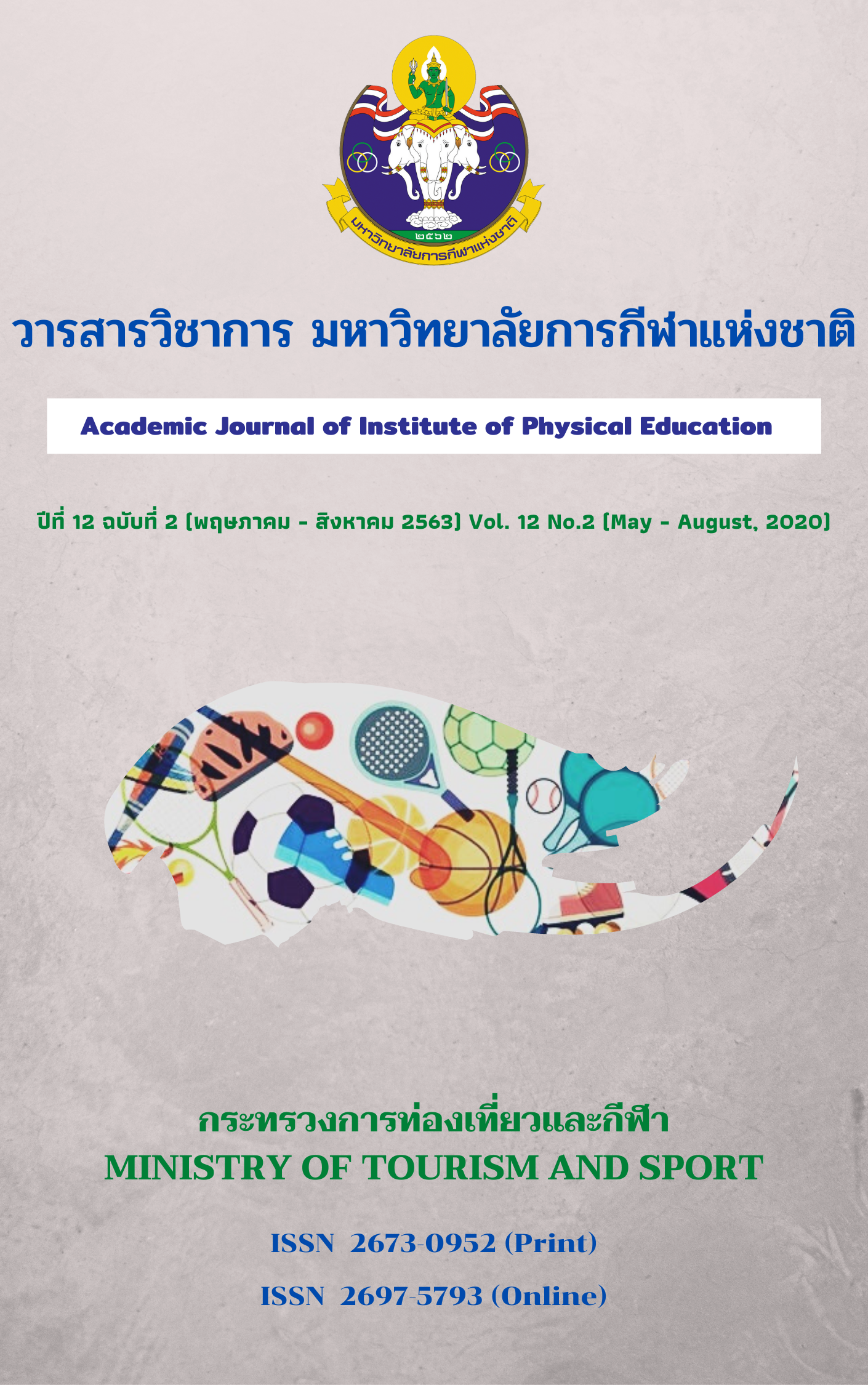FACTORS INFLUENCING SAFETY-HELMET WEARING BEHAVIORS TO PREVENT ACCIDENTS FROM MOTORCYCLE RIDING OF STUDENTS IN THE INSTITUTE OF PHYSICAL EDUCATION, CHON BURI CAMPUS
Main Article Content
Abstract
The objectives of this research were 1) to study knowledge pertaining to the usages and laws related to safety helmet, personal belief factors, cues to action, and behaviors in safety helmet wearing to prevent accidents from motorcycle riding; and 2) to study factors affecting behaviors in wearing safety helmet to prevent accidents from motorcycle riding of students in the Institute of Physical Education, Chon Buri Campus.
This study was a cross-sectional survey of 187 undergraduate students, capable of riding motorcycle, in the Institute of Physical Education, Chon Buri Campus. The tools for this research were the developed questionnaires based on the conceptual framework of the Health Belief Model with reliability coefficient of 0.90. Data were analyzed by percentage, mean, standard deviation, and stepwise multiple regression. All statistical tests were set at the significance level of 0.05.
The results revealed that 1) students in the Institute of Physical Education, Chon Buri Campus attained knowledge on usages and laws pertaining to safety helmet at a high level. The students’ beliefs in overall (five aspects) were rated at a moderate level. They received cues to action at a highest level, and students’ beliefs in the Institute of Physical Education, Chon Buri Campus wore safety-helmet in every time of motorcycle riding and about 35.83 percent were reported at a moderate level. 2) Self-efficacy and barrier in safety-helmet wearing, and information receiving could jointly predict the safety-helmet wearing behaviors at 30.20 percent carrying the statistically significant level of p < .05.
Article Details
The published article is a copyright of the Academic Journal of Thailand National Sports University. The passage appeared in each article in this academic journal is a perspective of each author which is not related to the journal. Each author is required to be responsible for all components of his/her own article. If there are any mistakes, each author must be responsible for those mistakes on his/her own.
References
Aghamolaei, T., Tavafian, S. S., & Madani, A. (2011). Prediction of helmet use among Iranian motorcycle drivers: An application of the health belief model and the theory of planned behavior. Traffic Injury Prevention, 12(3), 239-243.
Ambak, K., Ismail, R., Abdullah, R. A., & Borhan, M. N. (2010). Predicting helmet use among Malaysian motorcyclist using structural equation modeling. Australian Journal of Basic and Applied Sciences, 4(10), 5263-5270.
Bazargani, H. S., Saadati, M., Rezapour, R., & Abedi, L. (2017). Determinants and barriers of helmet use in Iranian motorcyclists: A systemic review. Journal of Injury Violence Research, 9(1), 61-67.
Brijs, K., Brijs, T., Sann, S., & Trinh, T. M. (2014). Psychological determinants of motorcycle helmet use among young adults in Cambodia. Transportation Research Part F: Traffic Psychology and Behavior, 26, Part A: 273-290.
Champion, V. L., & Skinner, C. S. (2008). The health belief model in K. Glanz, B. K. Rimer, & K. Viswaanath Eds. Health behavior and health education: Theory, research and practice. (4th ed.). San Francisco, CA.: Jonh Wiley & Sons.
Dissakoon Chonsalasin, Siradol Siridhara, Vatanavongs Ratanavaraha, Sajjakaj Jomnonkwao, & Duangdao Watthanaklang. (2017). A study of factors affecting Intention of helmet use: An application of the theory of health belief model. Technical Education Journal King Mongkut’s University of Technology North Bangkok, 1, 26-35.
Cohen J. (1988). Statistical power analysis for the behavioral sciences. (2nd ed.). Hillsdale, NJ: Lawrence Erlbaum Associates, Publisher.
Department of Land Transport. (2018). Numbers of registered cars in Thailand. (accumulation numbers to the present). Retrieved July 10, 2018, from https://data.go.th/Datasets.aspx?kw=%E0%B8%88%E0%B8%94%E0%B8%97%E0%B8%B0%E0%B9%80%E0%B8%9A%E0%B8%B5%E0%B8%A2%E0%B8%99.
Jetsada Kumphong, Thaned Satiennam, Wichuda Satiennam, & Tu Anh Trinh. (2018). Psychologygical models for development of motorcycle helmet use among students in Vietnam. IOP Conference Series: Earth and Environmenttal Science, 143, 1-7.
Oruogi, M., Hekmatpou, D., & Javaheri, J. (2014). The implication of health belief model to promote the performance of motorcyclists using helmets in Markazi province in Iran, Iranian Journal of Epidemiology, 9(3), 37-44.
Papadakaki, M. G., Tzamalouk, G., Orsi, C., & Kritikos, A. (2013). Barriers and facilitators of helmet use in a Greek sample of motorcycle riders: Which evidence, Transportation Research Part F. Psychology and Behaviour, 18, 189-198.
Poojadkarnonline. (2018). Unwearing helmets may cause to be severe injury or dead. Retrieved December 28, 2018, from https://mgronline.com/goodhealth/detail/
Rosenstock, I. M., Strecher, V. J., & Becker, M. H. (1988). Social learning theory and the health belief model. Health Education Quarterly, 15(2), 175-183.
Royal Thai Police. (2016). A statistical report of road traffic legal action in Thailand, 2013-2015. Bangkok.
Sureepun Vorapongsathorn. (2015). Research in health education. (3rd ed.). Bangkok: Witoon Karnpok.
Thai Roads Foundation and Road Safety Watch. (2017). A report of safety helmet wearing of motorcycle drivers in Thailand, 2018. Bangkok: Thai Roads Foundation.
Thavatchai Vorapongsathorn & Sureepun Vorapongsathorn. (2018). Sample size calculation for research using G*Power program. Journal of Health Promotion and Environmental Health, 41(2), 11-21.
World Health Organization. (2018). A global status report of road safety in 2018. Retrieved June 15, 2018, from http://news.ch3thailand.com/local/83995.


